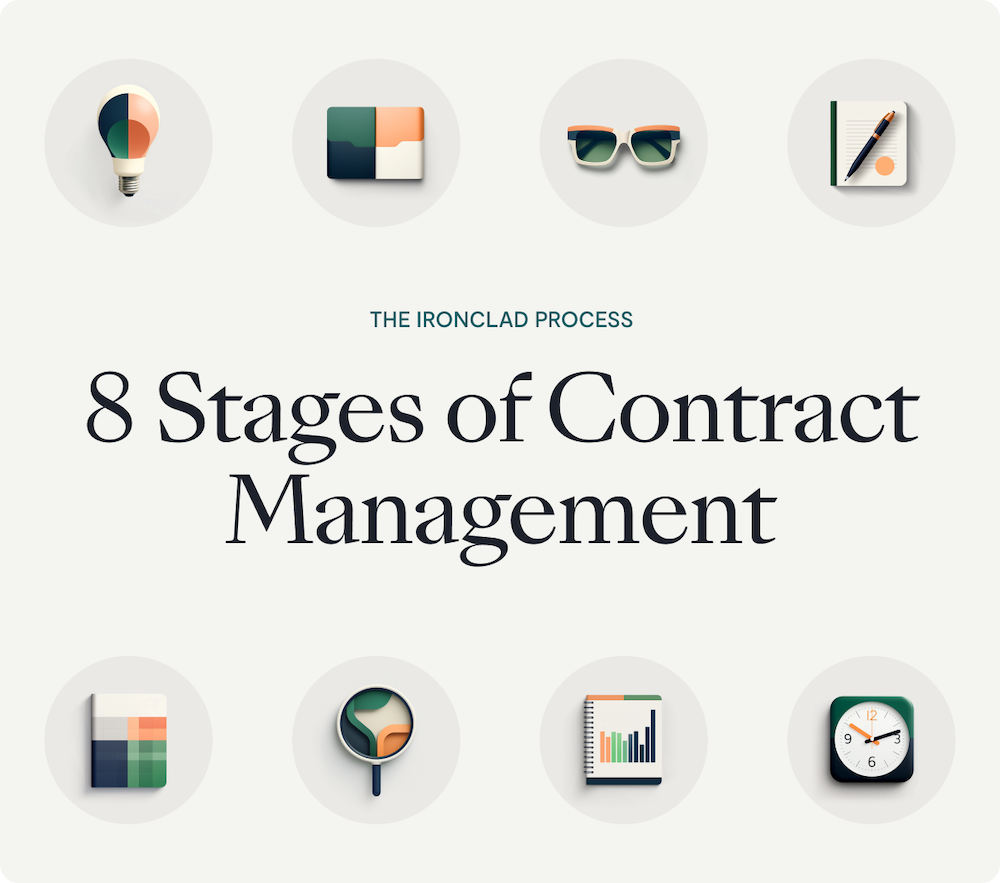What is contract management?
Contract management is the process of digitally maintaining agreements made with customers, vendors, partners, or employees. This encompasses creating, managing, sharing and archiving business contracts, and should allow in-house legal and its business users to automate management processes while extracting business intelligence from those contracts. It’s also an opportunity to save time, increase revenue, and extract insights.
Today’s chronically understaffed in-house legal teams, charged with managing contracts and mitigating related business risks, are often unable to keep pace. Rather than looking out for the best interests of the business — negotiating better deals, keeping ahead of agreement renewals or spotlighting risky contract clauses — they spend inordinate time on paper chasing, signature tracking and redline review. 50% of business leaders report that contracting inefficiencies have resulted in lost business.
Contract management is your business’ biggest opportunity.
What is contract lifecycle management?
Contract lifecycle management (CLM) take the concept of contract management a step further. The addition of the word “lifecycle” denotes end-to-end management of contracts throughout all stages of the process. “Contract management” and “CLM” are often used interchangeably, and most often as shorthand for contract management software.
What is contract management software?
Contract management software is a digital platform designed to help legal and other business departments easily create, negotiate, maintain, and renew agreements.
Contract management software streamlines your contract management lifecycle. It helps you with each step of the contract management process and streamlines your efforts along the way. How does it do this? Effective CLM software uses tools that help you manage your agreements step-by-step through the contract lifecycle. These tools automate processes and give you access to critical metadata you can use to increase your bottom line.
Contract creation with a workflow designer
You can create and automate customized agreements with a workflow designer. This self-serve tool works without long implementation times or the need for high-level technical expertise. It uses a drag-and-drop interface so users can build and launch contract generation processes quickly.
A department can set up a centralized location for any contracting requests both on company paper and third-party paper. It is as simple as:
- Uploading a template
- Tagging any fields that the requestor must provide
- Adding approvers and signers
- Adding conditional contract clauses and approvers when needed
Negotiation and collaboration
Your business departments can use contract management software to negotiate and collaborate throughout the contract lifecycle. An editor tool empowers you to redline and revise contracts in one place without forcing your counterparties to do the same. You can negotiate on one platform or permit others to work with the technology they are used to.
The collaboration software makes it easy to:
- Edit and revise contract provisions
- Track changes made by various users and counterparties
- Use @mentions and internal comments to loop in colleagues
- Accept or reject tracked changes
- Standardize clause substitutions
- Accelerate negotiations with standard language that may be readily adapted
- Get Word/DOCX native capability for seamless negotiation
Dynamic contract repository
A dynamic repository is more than just a place to store your contracts. It illuminates the valuable data contained within them, giving your legal team and other departments access to critical tools that:
- Allow an intuitive search, including structured and full-text searches
- Measure process metrics
- Provide contract data reporting
- Capture and secure agreements instantly
- Use smart import technology for easy contract ingestion
- Answer contract questions in seconds (i.e., When is the renewal date on X?)
Many companies still use antiquated methods like paper or server storage. This makes it easy to lose documents and miss important dates contained therein. The dynamic repository ends the problem of scattered records.
A smart solution, powered by artificial intelligence, gives you the tools to mitigate and reduce risk. Knowing what is in your contracts and where to find them saves time and reduces the risk of potential litigation.
Contract and data security
Contract management software also secures your agreements and valuable data. You want to know these critical documents are protected while they are stored, transferred, and processed.
CLM software is built on a secure infrastructure to ensure your agreements are always protected. It also helps you develop and implement policies to create a culture of security within your team.
The right software makes security a priority and has important features like:
- SOC 2, Type II certification
- GDPR compliance
- A comprehensive data retention policy
- Controlled user permission management
- Encryption for all data in transit and at rest
- Regular penetration and vulnerability testing
Clickwrap agreements
Clickwrap agreements are an easy, one-click method to secure contract acceptance. They are used in countless types of contracts to streamline how a consumer or counterparty accepts an agreement. Users simply click a box, button, or words that indicate “I agree.”
A single click replaces the physical act of signing or a clunky e-signature. These agreements are the best way for your business to limit risk without negatively impacting the customer experience. These are commonly added to sign-up pages, login pages, and checkout flows. However, nearly any type of agreement can utilize them.
Contract acceptance is one of the essential parts of the contract management lifecycle. You need an easy yet enforceable method for your contracts. An effective CLM software helps you comply with clickwrap best practices to ensure your agreements are enforceable.
Integrations with contract management software
A comprehensive contract management software system recognizes that your departments need to collaborate across multiple business systems to be most efficient. The right CLM software will also give you integrated access to Salesforce, DocuSign, Box, Egnyte, and more. Now you have the power of your CLM software coupled with solutions from other vendors. This lets you unlock the full potential of your business across every team.
Why is contract management needed?
As in-house legal and other business teams are being asked to do more with less, identifying and implementing the right tools, techniques and technology can mean the difference between unmanageable backlogs and efficient operations.
Contract management and contract management systems started gaining traction in the early 2000s. Prior, in-house legal teams cobbled together their own ad-hoc management solutions — such as email chains and spreadsheets — or used complex database management systems to manage their contracts.
Because legal teams historically had contracts scattered all over the place — in filing cabinets, on local drives and elsewhere — this decentralization exposed companies to significant risks. That’s why, in the early days, contract management tended to focus only on the post-execution piece of the puzzle, i.e., storage of agreements in one centralized place.
However, contracts were still viewed as static documents requiring a static solution, which often turned out to be a “file-and-forget” solution, i.e., a one-way trip to the archives. The logical answer was the contract database. As anyone who works with contracts knows, contracts are living documents — think upcoming renewal dates, force majeure clauses, the impact of changing state and federal regulations — requiring living solutions.
What are the challenges of contract management?
There are many types of contracts used in business, like Non-Disclosure Agreements (NDAs), vendor agreements, order forms, Master Service Agreements (MSAs), Statements of Work (SOWs), and many more.
While in-house legal counsel usually reviews or approves contracts, they’re necessary for every other department in the business, too, from procurement and finance to HR, sales, and marketing.
That’s exactly why it’s so hard to manage contracts: Every department handles them differently, creating an isolated and disjointed system that slows down the business and puts it at risk. Contract management has always been a cross-functional problem without a cross-functional solution.
Contracts hold your business together. They sit at the core of every major part of your company, guiding every decision, relationship, project, and transaction. Contracts contain more risk and more reward than any other part of modern business—and yet, they’re often the most chaotic and mismanaged.
Nearly every business’ contract management processes are rigid and time-consuming, causing friction and delays that prevent your company’s ability to close deals and execute on important business operations. Ultimately, this leads to many negative outcomes for your business, including isolated decisions, increased risk, and revenue leakage that may occur from bad management like missing a renewal date.
In-house legal teams end up spending all their time and energy trying to manage contracts instead of focusing on strategic initiatives that help drive the business forward.
Contracts are viewed as static, one-time documents, rather than what they truly are: Dynamic, data-rich documents that have the potential to unlock massive value for businesses.
Enter: Contract Lifecycle Management (CLM), created to help contracts and anyone who handles them, including in-house legal and legal operations teams, realize their full potential in driving business value.
What are the basic elements of a contract?
Although this includes new and evolved elements of the contract process, here are the 6 essential elements of a contract that remain the same:
- Offer: Something your business or counterparty wants and who will be held responsible for it.
- Acceptance: A response to the offer. If it’s accepted, this could also include conditional acceptance, acceptance by action, or option agreement. When it comes to digital contracts, you can choose the best mode of acceptance for the agreement, from electronic signatures for high-negotiation agreements to clickwrap for no-negotiation agreements.
- Awareness: Mutual acknowledgement of the agreement. With digital contracting, this is no longer a step that requires one version of the contract to be sent back and forth for signing. CLMs allow both parties to acknowledge and sign the same version of the agreement, no email or postage required.
- Consideration: The value, monetary or otherwise, of the goods or services the contract is providing.
- Capacity: All signatories must demonstrate that they clearly understand the contract before signing it.
- Legality: Acknowledgement that the contract is subject to the laws of the jurisdiction in which it operates. Since these clauses are different for every area of jurisdiction, digital contracting can help by having pre-approved templates and workflows with the correct language for your location.
See anything missing from this list? Here are some of the “necessary evils” of contracts you may be assuming that actually aren’t required:
- PDFs that are difficult to sign, hard to track, and become neglected in your inbox. Digital contracting means you’ll always have contracts that are easy to sign, track, and store, and ensures your team is always working on the latest version of a contract.
- Negotiation that happens in phone calls, email chains, and hundreds of contract drafts. Why should negotiation happen outside the contract itself? Digital contracting enables you to collaborate, negotiate, and align with counterparties on the same draft, in real time.
- Fear of redlines and revisions. Digital contracting makes it easy to edit within the contract and collaborate with colleagues on a shared platform. Even better? Ironclad has a DOCX-native experience to integrate seamlessly with your existing documents.
- Losing track of contracts and the important information inside them. Digital contracting makes it so that you’ll never have to ask where a contract lives again, and you’ll never miss a future renewal.
Contracts are also hard to manage because most businesses have settled for an outdated perception of what a contract needs to be. For example, if you’re thinking about contracts as static digital paper, you’re missing out on how they could drive your business forward.
Companies like Mastercard, L’Oréal USA, Asana, Lyft, Dropbox, Glassdoor, Bitmovin, and more have shifted to a new way of thinking about contracts: digital contracting is the missing piece of contract management that not only simplifies the contract lifecycle within your organization, but it also drives value and uncovers new opportunities for success.
What's the contract management process?
The contract management lifecycle involves many stakeholders and steps, so it’s important to choose a CLM that simplifies the process so users don’t have to worry about it.
This will make things easier on your entire cross-functional team—Legal will be happy because they’ll get fully formed, enforceable contracts without the complexity of having to explain the legal process to business users with each contract. In turn, business users get to go through a simple series of prompts and come out the over end with a legitimate contract.
Let’s explore the eight steps of the contract management process: Create, negotiate, approve, accept, fulfill, analyze, optimize, and renew.
Step 1: Generate
During the contract creation or generation step:
- You set the tone for the rest of the contract management process
- Contract requests are sent to the legal department
- Determine stakeholders and confirm internal alignment
- The legal team creates the contract.
With Ironclad:
- Empower business users from all departments to self-service their own contracts
- Legal is only looped in when they need to be
- Create easy-to-use workflows that are customized to your specific contract process.
Step 2: Contract Negotiation
During the contract negotiation process:
- You communicate with your counterparty to come to an agreement
- Redline and edit contracts.
With Ironclad:
- Use Ironclad Editor to collaborate internally, make edits, and resolve redlines
- Gain full transparency into your contract’s status
- Enjoy a DocX-native experience.
Step 3: Contract Approval
During the contract approval stage, you’ll:
- Run the contract by every business stakeholder for review
- Come to an internal agreement to proceed with the contract.
With Ironclad:
- Internal review and approval can all happen within the same platform
- Automatically send to the correct reviewers at the right step in the process.
Step 4: Accept
During the contract acceptance stage, your business will:
- Decide how to sign the contract (wet signature, electronic signature, clickwrap)
- Sign the contract.
With Ironclad:
- Choose the best mode of acceptance
- You can sign contracts of any negotiation level.
Step 5: Fulfill
During the fulfillment stage:
- Both parties are held accountable to their contractual obligations.
With Ironclad:
- The Data Repository serves as another layer of accountability for renewals and other obligations.
Step 6: Analyze
During the contract analysis stage, you:
- Collect and review meta data from your contracts
- Store your contracts in a Repository
With Ironclad:
- Unlock data and new opportunities using your contract metadata and the Data Repository.
- Answer questions about contracts faster by having one reliable place to keep and search for them.
Step 7: Optimize
During the optimization step, you’ll:
- Put your data to work, using your findings to improve processes, increase efficiency, or drive business.
With Ironclad:
- Use intelligent alerts, process automation, and cross-system integrations to improve business operations and find opportunities for growth with the Data Repository.
Step 8: Renew
During contract renewal, the last step of the contract management lifecycle, you’ll:
- Decide whether or not to renew your contract.
With Ironclad:
- Create alerts for upcoming renewals and stay on top of any additional action needed using the Data Repository.
What are the benefits of contract management?
Innovative companies with ambitious long-term goals are turning to CLM platforms because it is the only true way to make sure their contract process keeps up with the pace of modern business. Here are some of the benefits these organizations experience.
Save time
With digital contracting, you’ll eliminate the headache and hurry-up-and-wait culture surrounding contracts by implementing one robust platform that anyone can use.
Reduce turnaround time: Dropbox uses Ironclad to fast track 2000 Inbound Services Agreements and Statements of Work per year, reducing turnaround times from 2 weeks to minutes and eliminating hundreds of contract tickets.
See how Dropbox reduced Legal’s turnaround time from two weeks to two minutes.
Reduce contract volume
Digital contracting allows you to scale and automate much of the contract process, which means you’ll reduce the number of individual contracts to be created and reviewed.
Encourage collaboration
CLM software makes it easy to collaborate within one unified platform, making edits everyone can see and accepting redlines once and for all. It also allows you to work more quickly and get answers to your leadership’s pressing questions.
See how Asana improved sales and legal collaboration to close deals faster.
Reduce risk
Many businesses believe that saving time on their contract process is equivalent to cutting corners, which would put them at larger risk than manually creating and reviewing each contract. But with the right CLM solution, this isn’t a concern at all—in fact, digital contracting keeps your team accountable, provides transparency, and creates alerts to maintain and increase your security and compliance.
See how AppDynamics achieved 100% sales compliance.
Increase revenue and savings
When it comes to using CLM platforms to save money during the contract process, Fitbit is a great example, with over $60,000 saved annually from contract generation and routing automation alone.
Reduce external counsel spend
Bitmovin’s GC used Ironclad to expedite high-volume sales agreements, achieve substantial savings on outside counsel, and ensure all of their contracts were organized in a central repository. This resulted in an estimated $400K reduction in outside counsel spend.
Who uses contract management software?
Innovative companies with ambitious long-term goals are turning to CLM platforms because it is the only true way to make sure their contract process keeps up with the pace of modern business. Here are some of the benefits these organizations’ experiences.
Legal
General Counsel and the in-house legal team, which may include legal operations, usually own the contract process within an organization. They use legal contract management software on a daily basis to oversee the entire contract lifecycle, from creation to renewal. Legal teams will most likely be found creating workflow templates, writing clauses, negotiating terms, or reviewing revisions within the contract management software.
HR
HR processes a lot of contracts in the employment process, which is why it’s necessary for them to have access to contract management software. You can find them sending standardized contracts that have been pre-approved by legal, like offer letters, Non-Disclosure Agreements, and Statements of Work.
Sarepta Therapeutics used Workflow Designer to create HR-specific workflows, routing each contract to the appropriate approver, streamlining the process overall and driving adoption throughout the organization.
Procurement
Since procurement teams are responsible for obtaining goods and services for the company from third parties, procurement contract management is an important aspect to consider when evaluating CLMs. Procurement teams can frequently be found making contract requests to legal, so choosing a CLM platform where they can self-service their own contracts is key.
Finance
Finance teams rely on contract management software to help them inform the budget, forecast revenue, and find billing information. When COVID-19 hit, Ironclad’s own finance team was able to use our CLM platform to quickly identify the company’s current and upcoming payment obligations. They created a procurement workflow that identified payment obligations for contracts that were in-flight before they were even signed, allowing them to plan more strategically for the financial unpredictability of the pandemic.
Sales
Sales teams need to move quickly to close deals, and contract management software helps them do just that. By using a workflow and template created by legal, they’re able to self-service their contracts and integrate with other systems they use, like Salesforce.
Before they started using Ironclad, Asana’s sales team encountered friction and delays in their sales contracting process. But with a CLM that encourages collaboration, the relationship between sales and legal is stronger and more efficient than ever.
Marketing
Marketing teams make many contract requests, some for services, like vendor agreements for a new software or tool, and others for working relationships, like contractors that require influencer agreements or photography releases.
They have campaigns to launch and goals to reach, so it’s imperative they have a CLM that can keep up.
Connect with teams like yours
If you’re looking to connect with others like you, learn from top legal leaders, and gain innovative insights about your contract process, the Ironclad Community is for you. It’s the world’s leading digital contracting community, created to define the future of contracts together.
Will digital contract management last?
One study by IACCM found that even a low-risk contract costs an average of $6,900 to process.
Costs for a mid-complexity contract averages $21,300, and high-complexity contracts run into hundreds of thousands of dollars. And these costs are rising.
To transform Legal from cost center to business center, forward-thinking businesses are looking to contract management workflows — standardized processes for shepherding contracts through various approvals and systems efficiently. Unfortunately, without modern tools, workflows involve many manual steps. For example, a typical workflow for a legal team may involve word processing software for drafting contracts and redlines, email for collaboration and negotiation, and a CLM for tracking.
Hallmarks of modern digital contract management, workflow technologies stem from the need to shepherd digital contracts across functions, organizations and systems. These tools deliver key efficiency and business-driving features, from a single platform, including:
- Document creation
- Automated approvals triggered by predefined conditions
- E-signature
- Contract repository
- Integrations with contract-adjacent systems like Salesforce
Giving users visibility into every step of the contract management process, digital contract management platforms are also:
- Cloud-native and data-driven through every step of the contract management process
- Designed to enable real-time collaboration and negotiation
- Capable of synching with all other systems and business users who need to consume contract information
- Built around core concepts of usability to help ensure businesses can onboard quickly and give teams powerful tools they want to use
The result is contract management that coordinates and connects every person, every step and every system relevant to contracts — establishing a digital contracts hub for businesses. In effect, this is helping a new breed of senior counsel and legal operations professionals escape their siloed, informational black boxes to become data-driven doers who can illuminate contract metadata (e.g., renewals or force majeure clauses) and process data (e.g., time and cost to process contracts) to advance business priorities.
What will distinguish in-house leaders from laggards in this new world? How they use contract data.
Successful legal teams will be those who harness contract data to protect their businesses, save money and provide business-critical insights. In the process, they will uplevel their own value to the organization by becoming trusted business advisers.
Contracts must first catch up to the pace of business, then evolve far enough ahead to lead the way to the future.
How do I choose CLM software?
If you’re thinking about implementing contract management for the first time, here are a few things to consider:
- Experience the software: Find a CLM solution that will let you experience their platform first-hand before you make your decision. Sandboxes are a critical part of the CLM evaluation process because you can clearly understand what you’ll be using day-to-day.
- Choose a long-term partner: 50% of CLM implementations fail (Gartner), and that’s because companies pick the easiest, cheapest route with little-to-no support. Make sure you’re partnering with a CLM platform that has the experience (Legal engineers and customer support) and expertise to help you implement successfully and drive adoption throughout your organization.
- Focus on your most pressing contract type first: When you implement a new CLM solution, it’s tempting to use it for all of your contracts right away, but the best way is to start with one contract type and go from there. This speeds up your time-to-value, meaning you’ll start getting value out of the product as soon as you stand up your first workflow.
- Look for resources: An indication of a strong CLM choice is the amount of resources they provide for continued learning and inspiration, like implementation guides and articles on contract management. Make sure your CLM will continue to help you reach your goals.
Here’s what current customers have to say about their implementation process with Ironclad:
- It’s simple to set up and easy for any member of your team to use.
- Make any changes or iterations without consulting your IT team.
- Find the support you need with legal engineers and customer success teams.
- Your entire business will love using Ironclad.
Learn more about partnering with Ironclad for a successful CLM implementation.
What if every business could fast track their contracts — NDAs, BPAs, MSAs, influencer agreements — from creation to redlines to signature sign-off to archiving, so they can focus less on paperwork and more on legal work? And all from a single platform, without relying on multiple, disconnected systems, including static storage archives?
From making to managing to storing, a digital contacting platform like Ironclad can streamline and automate every part of the contract management process, going beyond what simple storage databases or legacy CLM systems can offer.
“Going digital” and automating the entire contract management process not only mitigates business risk by quickly spotlighting risky clauses but also prevents rogue contracting by eliminating the use of outdated or unapproved templates that leave businesses open to liabilities.
Ironclad, for example, enables legal teams to:
- Implement contract workflows to automate agreement creation, providing self-serve contract management for business users in any department
- Bake data collection into the contracting process, so that contracts become a source of business intelligence
- Centralize contract storage to create a single source of truth for business that is easily accessible and searchable
- Power remote collaboration and negotiation, across teams and business users
- Work strategically by prioritizing team requests
“Contracts must first catch up to the pace of business, then evolve far enough ahead to lead the way to the future,” says Ironclad CEO Jason Boehmig. “They should be intelligent, automatic, and easy to use by both humans and computers. Contracts should be connected to the people and systems that need them, instead of buried in discarded emails and cluttered folders.”
If you’ve already implemented contract management but want to level-up your strategy and maximize your investment, consider these:
- Reporting: Is your CLM set up to gather the most helpful data for your business? When creating workflows, think about what questions you’d like your contracts to help answer.
- Data analysis: How long does it take to turn around a contract? Where do they get stuck? Instead of testing theories, analysis of your contract data helps you make informed decisions that will increase the ROI of your platform.
- Automation: The best way to scale the workflows that are already working and save time every step of the way.
What's in the future of contract management?
Until recently, contract management platforms and contract management techniques have been narrowly focused on pre- or post-contract legal needs like storage — to the detriment of the business. Modern businesses and enterprises today require tools that support the entire contract management lifecycle — for in-house Legal and legal operations as well as other departments like Sales and Finance who create or manage contracts. In this world, contact management can no longer be viewed as a lateral, static, one-way process. Instead, contracting must operate as the hub connecting and driving other business units.
From making to managing to storing, a robust contract management system should automate and streamline all contracts, from the simplest to the most complex, facilitating collaboration and negotiation for all contract stakeholders — even as they work remotely.
Unlike legacy CLM and contract management solutions, digital contract management (and the digital contracts it keeps) answers that need, engaging its business users with a modern, intuitive solution. You want to choose a CLM solution that will grow with your business and be a reliable long-term partner. Prioritize platforms that are easy-to-use for all business users, with features like Workflow Designer, Editor, and Repository. In the process, in-house Legal can go from manual, black-box contracts to data-rich contracting, collaboration and negotiation thanks to:
- Fast tracking the entire contract process, including negotiation, review and approval
- Enabling departments to launch their own contracting with confidence
- Being able to keep pace with the speed of business
The future of contract management is digital contracting that allows you to accelerate, control, and understand all of your contracts, from high-to-no-negotiation. When evaluating solutions, don’t be afraid to ask your CLM team specific questions about your use case and what updates are on the roadmap that you can look forward to. You want a solution that can handle any level of agreements while also focusing on the user experience and continuing education for all users.
In short, contract management efficiency can free legal counsel and legal ops teams from rote, repetitive, time-consuming activity in favor of becoming trusted, strategic business advisors to the organization.
Bonus quiz: test your contract management maturity!
Ironclad is not a law firm, and this post does not constitute or contain legal advice. To evaluate the accuracy, sufficiency, or reliability of the ideas and guidance reflected here, or the applicability of these materials to your business, you should consult with a licensed attorney. Use of and access to any of the resources contained within Ironclad’s site do not create an attorney-client relationship between the user and Ironclad.
- What is contract management?
- What is contract lifecycle management?
- What is contract management software?
- Why is contract management needed?
- What are the challenges of contract management?
- What are the basic elements of a contract?
- What's the contract management process?
- What are the benefits of contract management?
- Who uses contract management software?
- Will digital contract management last?
- How do I choose CLM software?
- What's in the future of contract management?
- Bonus quiz: test your contract management maturity!
Want more content like this? Sign up for our monthly newsletter.

















